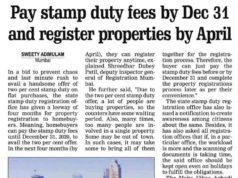In a landmark decision, the Income Tax Appellate Tribunal (ITAT) has held that a taxpayer can avail of tax benefits where long-term capital gains (LTCGs) arising on sale of more than one flat are invested or will be invested in one residential house in India, within the stipulated time.
It is not uncommon for taxpayers to sell more than one house to buy a larger accommodation or move to a tonier area. There have been instances where tax benefit claims made by taxpayers have been denied as sale proceeds of more than one flat were invested in a new residential property. This recent ITAT decision will benefit taxpayers in Mumbai and in the absence of any contrary jurisdictional order, will strengthen the case of other taxpayers.
If on sale of a residential house that has been held for at least two years, the taxpayer makes a profit, then such profit is treated as a LTCG. This gain is taxable at 20% with an adjustment for inflation referred to as indexation benefit. Section 54 of the Income Tax Act, which was the subject matter of the dispute, provides that if the investment is made in one house in India, in the stipulated period (see table for conditions prescribed), then to the extent of this investment, the taxable component of the LTCG is reduced, which results in a lower tax outgo.
The ITAT agreed with the contention of the taxpayer that Section 54 of the I-T Act has an inbuilt restriction that the capital gain arising from sale of a residential house cannot be invested in more than ‘one’ residential house, in India. However, there is no restriction that the capital gains arising from the sale of more than one residential houses can be so invested.
The bench held: “The provision of Section 54 is applied to the transfer of any number of residential houses by the taxpayer provided the capital gains arising therefrom are invested in a proper manner within the prescribed time period.”
In this case, Bipin N Sagar sold three adjoining flats and claimed exemption under Section 54. These flats were used as a single unit, with just one kitchen. But the I-T officer sought to deny the Section 54 benefits on the grounds that LTCGs arose on sale of three flats, and not just one, as the sale was via three separate agreements. During assessment, he added back a sum of Rs 1.88 crore to the income of the taxpayer for 2010-11.
The ITAT observed that in this case, the I-T officer had not disputed the evidence submitted by Sagar that the three adjoining flats were in fact united as one single unit. Notwithstanding this fact, there is no restriction placed anywhere in Section 54 that exemption is available in relation to sale of only one residential house, it added.
Incidentally, the interim budget has provided for an additional relaxation. It proposes to allow investments to be made in two house properties in India, but this option can be exercised only once in a lifetime.
The ITAT is the final fact-finding authority. The I-T department can file an appeal only if it involves a question of law. At this stage, it is not known whether the I-T department will file an appeal in the high court.
Source: TIMES NEWS NETWORK










